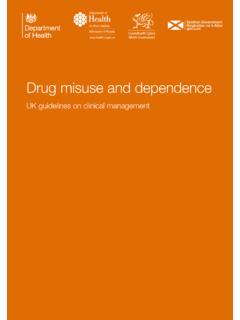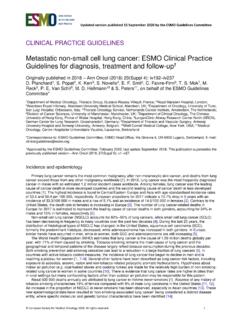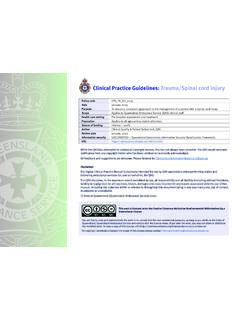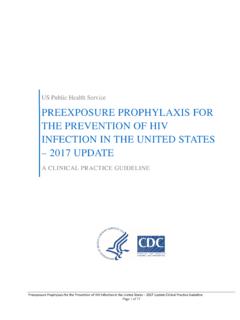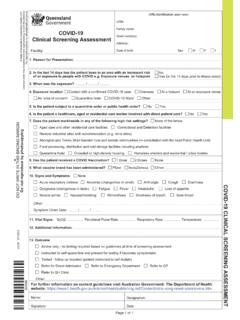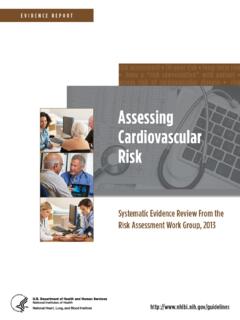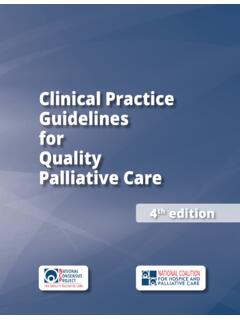Transcription of Prevention of Cardiovascular Disease
1 Prevention of Cardiovascular Disease guidelines for assessment and management of Cardiovascular risk WHO Library Cataloguing-in-Publication Data Prevention of Cardiovascular Disease : guidelines for assessment and management of total Cardiovascular risk. 1. Cardiovascular diseases Prevention and control. 2. Arteriosclerosis Prevention and control. 3. Risk factors. 4. Risk assessment . 5. guidelines . I. world health organization . ISBN 978 92 4 154717 8 (NLM classification: WG 120). world health organization 2007. All rights reserved. Publications of the world health organization can be obtained from WHO Press, world health organization , 20 Avenue Appia, 1211 Geneva 27, Switzerland (tel.: +41 22 791 3264; fax: +41 22 791 4857; e-mail: Requests for per- mission to reproduce or translate WHO publications whether for sale or for noncommercial distribution should be addressed to WHO Press, at the above address (fax: +41 22 791 4806.))
2 E-mail: The designations employed and the presentation of the material in this publication do not imply the expression of any opinion whatsoever on the part of the world health organization concern- ing the legal status of any country, territory, city or area or of its authorities, or concerning the delimitation of its frontiers or boundaries. Dotted lines on maps represent approximate border lines for which there may not yet be full agreement. The mention of specific companies or of certain manufacturers' products does not imply that they are endorsed or recommended by the world health organization in preference to others of a similar nature that are not mentioned. Errors and omissions excepted, the names of proprietary products are distinguished by initial capital letters. All reasonable precautions have been taken by the world health organization to verify the information contained in this publication.
3 However, the published material is being distributed without warranty of any kind, either expressed or implied. The responsibility for the interpreta- tion and use of the material lies with the reader. In no event shall the world health organization be liable for damages arising from its use. Printed in Design by In s Contents Abbreviations and acronyms used in this document .. v Executive summary ..1. Introduction ..2. Background, scope and purpose of the guidelines ..2. Interpretation and implications of recommendations ..3. Development of the guidelines ..4. Part 1 The total risk approach to Prevention of Cardiovascular Disease .. 5. Rationale for targeting high-risk groups ..6. Complementary strategies for Prevention and control of Cardiovascular Disease ..7. Threshold for interventions ..8. Risk prediction charts: strengths and limitations.
4 9. The WHO/ISH Cardiovascular risk prediction charts ..13. Clinical assessment of Cardiovascular risk ..14. When can treatment decisions be made without the use of risk prediction charts?..16. Applying the WHO risk prediction charts ..16. Goals of appplying the Prevention recommendations..18. Part 2 Recommendations for Prevention of Cardiovascular Disease .. 19. Levels of evidence and grades of recommendations ..20. Recommendations ..22. Part 3 Basis of recommendations (the best available evidence).. 27. 1. Modification of behaviour ..28. Tobacco ..29. Diet ..30. Physical activity ..35. Body weight ..36. Alcohol ..37. iii 2. Psychosocial factors..38. 3. Multiple risk factor interventions..40. 4. Blood pressure lowering ..40. Targets for blood pressure ..41. Choice of initial drug therapy ..41. 5. Lipid lowering ..45. Benefits ..45. risks .
5 49. Monitoring of treatment ..50. 6. Cost-effectiveness, feasibility and resource implications of antihypertensive and statin therapy ..51. 7. Control of glycaemia ..52. 8. Aspirin therapy ..53. risks ..54. Balance of risks and benefits ..54. 9. Fixed-dose combinations..55. 10. Hormone therapy ..56. References ..57. ANNEX 1. WHO Member States by subregion, classified according to mortality stratum ..73. ANNEX 2. Proportion of the population in each risk category, by WHO subregion ..75. ANNEX 3. Sample WHO/ISH risk prediction chart, for use where measurement of cholesterol level is possible ..79. ANNEX 4. Sample WHO/ISH risk prediction chart for use where measurement of cholesterol level is not possible ..81. ANNEX 5. Methods of development of WHO/ISH risk prediction charts ..83. ANNEX 6. Guideline Development Committee..84. ANNEX 7. Peer reviewers.
6 85. Risk prediction charts for countries of the 14. WHO epidemiological subregions .. (in compact disc on back cover). iv Prevention of Cardiovascular Disease Abbreviations and acronyms used in this document ACE angiotensin-converting enzyme ALERT assessment of Lescol in Renal Transplantation ALLHAT Anti-hypertensive and Lipid-Lowering Treatment to Prevent Heart Attack Trial ARB angiotensin receptor blocker ARIC Atherosclerosis Risk in Communities ASCOT Anglo-Scandinavian Cardiac Outcomes Trial BMI body mass index CARDS Collaborative Atorvastatin Diabetes Study CARE Cholesterol and Recurrent Events [Study]. CCB calcium-channel blocker CHD coronary heart Disease CI confidence interval CVD Cardiovascular Disease DALY disability-adjusted life year DASH Dietary Approaches to Stop Hypertension DCCT Diabetes Control and Complications Trial ECG electrocardiogram FIELD Fenofibrate Intervention and Event Lowering in Diabetes [Study].
7 GDG Guideline Development Group GRADE Grades of Recommendation, assessment , Development and Evaluation HDL-C high-density lipoprotein cholesterol HOT Hypertension Optimal Treatment [Trial]. HPS Heart Protection Study HRT hormone replacement therapy ISH International Society for Hypertension LDL low-density lipoprotein LLT Lipid Lowering Trial PROSPER Prospective Study of Pravastatin in the Elderly at Risk QALY quality-adjusted life year RCT randomized controlled trial RR relative risk SCORE Systematic Coronary Risk Evaluation SIGN Scottish Intercollegiate guidelines Network TC total cholesterol UKPDS United Kingdom Prospective Diabetes Study WHO world health organization WOSCOPS West of Scotland Coronary Prevention Study v vi Prevention of Cardiovascular Disease Executive summary Cardiovascular Disease is a major cause of disability and premature death throughout the world , and contributes substantially to the escalating costs of health care.
8 The underlying pathology is atherosclerosis, which develops over many years and is usually advanced by the time symptoms occur, generally in middle age. Acute coronary and cerebrovascular events frequently occur suddenly, and are often fatal before medical care can be given. Modification of risk factors has been shown to reduce mortality and morbidity in people with diagnosed or undiagnosed Cardiovascular Disease . This publication provides guidance on reducing disability and premature deaths from coronary heart Disease , cerebrovascular Disease and peripheral vascular Disease in people at high risk, who have not yet experienced a Cardiovascular event. People with established Cardiovascular Disease are at very high risk of recurrent events and are not the subject of these guidelines . They have been addressed in previous WHO Several forms of therapy can prevent coronary, cerebral and peripheral vascular events.
9 Decisions about whether to initiate specific preventive action, and with what degree of intensity, should be guided by estimation of the risk of any such vascular event. The risk prediction charts that accompany these guidelinesb allow treatment to be targeted accord- ing to simple predictions of absolute Cardiovascular risk. Recommendations are made for management of major Cardiovascular risk factors through changes in lifestyle and prophylactic drug therapies. The guidelines provide a framework for the development of national guidance on Prevention of Cardiovascular Disease that takes into account the particular political, economic, social and medical circumstances. a world health organization . Prevention of recurrent heart attacks and strokes in low and middle income populations. Evidence-based recommendations for policy makers and health professionals.
10 Geneva, 2003 ( ). b Risk prediction charts for each WHO subregion (and country) are available with the pocket version of these guidelines . Executive summary 1. Introduction Background, scope and purpose of the guidelines Of an estimated 58 million deaths globally from all causes in 2005, Cardiovascular Disease (CVD). accounted for 30%. This proportion is equal to that due to infectious diseases, nutritional deficiencies, and maternal and perinatal conditions combined (1). It is important to recognize that a substantial pro- portion of these deaths (46%) were of people under 70 years of age, in the more productive period of life; in addition, 79% of the Disease burden attributed to Cardiovascular Disease is in this age group (2). Between 2006 and 2015, deaths due to noncommunicable diseases (half of which will be due to Cardiovascular Disease ) are expected to increase by 17%, while deaths from infectious diseases, nutritional deficiencies, and maternal and perinatal conditions combined are projected to decline by 3% (1).










